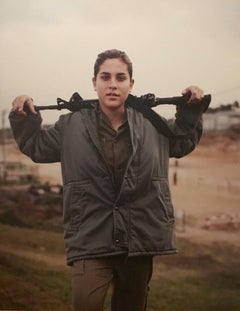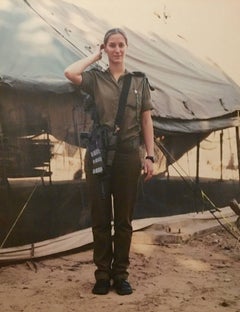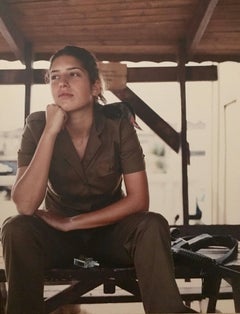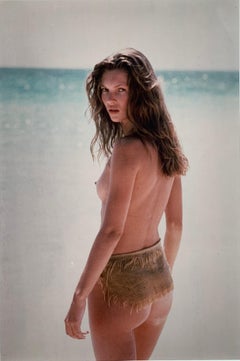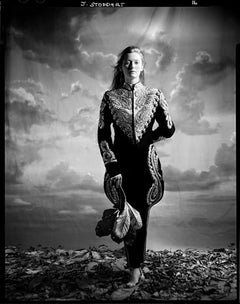Ashkan Sahihi Portrait Photography
to
3
Overall Width
to
Overall Height
to
3
3
3
2
2
1
1
1
1
1
1
1
1
1
3
3
1
3
1,989
1,356
241
211
3
Artist: Ashkan Sahihi
WOMEN OF THE IDF Large color Photograph LITAL
By Ashkan Sahihi
Located in Surfside, FL
"Women of the IDF" Large Exhibition color Photograph
30 x 40 inches, mounted on masonite and laminated.
Edition of 4 + 2 artists proof. minor dings and bumps to edges Born in Tehran, Iran, Ashkan Sahihi moved with his family to West Germany at the age of seven. Although he began taking photographs as a teenager, Sahihi traces the beginning of his professional trajectory to New York in 1987, a thriving “pop culture metropolis” where he could do the kind of photography work that he wanted to do, exploring the underbelly of the society around him. Taking assignments from German publications such as the Süddeutsche Zeitung Magazine, Der Spiegel, Dummy and GEO, he photographed subjects like prisoners on death row, players in the hip-hop scene, and the downtown art scene of New York. Neither black nor white, an insider among outsiders, he found himself able to navigate spaces and dynamics that others might have had difficulty entering. He considered this both a privilege and an obligation – to visit these places and tell these stories. His success led to commissions from American publications as well, including the New York Times Magazine, the New Yorker, Rolling Stone, and Vogue.
Put off by the limitations of photojournalism (the expectation that he would illustrate the writer’s perspective rather than author a narrative of his own), Sahihi began to embark on independent, highly compact conceptual series. His main goal in these series has been to drive forward public discourse on topics he believes have not provoked enough or the right kind of discussion: drugs, gender in the media, women in the military, etc. His portraits draw on a familiar visual language – often seated subjects before a neutral backdrop – but push the viewer to feel and think about entirely new things. Although he constantly challenges the comfort level of both the viewer and the subject, Sahihi never removes himself from the line of fire; all of his work requires the artist to immerse himself in uncomfortable situations and challenge his own emotional fortitude.
Photographic Series
In the “Face Series”, latex-gloved hands manipulate the subjects’ features, stretching, pushing, squeezing, pinching at the whim of external direction – from the artist? The customer? The public? The “Hypnosis Series” comprises 8 portraits of hypnotized subjects each experiencing a single emotion, e.g. helplessness, withholding/anger, or regret. In a society that rewards the suppression of such naked emotion, the purity of these depictions is arresting.
In 2006, Sahihi photographed himself in the homes and with the families of six ex-girlfriends and one ex-wife, imposing himself more or less awkwardly on the constellations that emerged after he had exited their lives (“Exes Series”).
For Sahihi’s most well-known work, the “Drug Series,” he convinced 11 non–drug users to consume a particular drug, then took their portraits over the course of their trips. The series was born out of Sahihi’s frustration with the hypocrisy of the political conversation about drugs in the United States. “By attempting to present an objective image of drug use, the artist addresses the cultural politics that allow our society to simultaneously glamorize the ‘drug look’ in fashion magazines and the entertainment industry and meanwhile turn a blind eye to the complicated, and vast, problem of drug abuse.” Sahihi has exhibited this series at MoMA PS1 New York in 2001, in Dresden in 2008, and alongside his installation “100 Million in Ready Cash."
Sahihi’s dense explorations through small photographic series include “Women of the IDF," portraits of female Israeli soldiers...
Category
Early 2000s Ashkan Sahihi Portrait Photography
Materials
Masonite
WOMEN OF THE ISRAEL DEFENSE FORCES Large Photo NETA
By Ashkan Sahihi
Located in Surfside, FL
"Women of the IDF" Large Exhibition color Photograph
30 x 40 inches, mounted on masonite and laminated.
Edition of 4 + 2 artists proof. minor dings and bumps to edges Born in Tehran, Iran, Ashkan Sahihi moved with his family to West Germany at the age of seven. Although he began taking photographs as a teenager, Sahihi traces the beginning of his professional trajectory to New York in 1987, a thriving “pop culture metropolis” where he could do the kind of photography work that he wanted to do, exploring the underbelly of the society around him. Taking assignments from German publications such as the Süddeutsche Zeitung Magazine, Der Spiegel, Dummy and GEO, he photographed subjects like prisoners on death row, players in the hip-hop scene, and the downtown art scene of New York. Neither black nor white, an insider among outsiders, he found himself able to navigate spaces and dynamics that others might have had difficulty entering. He considered this both a privilege and an obligation – to visit these places and tell these stories. His success led to commissions from American publications as well, including the New York Times Magazine, the New Yorker, Rolling Stone, and Vogue.
Put off by the limitations of photojournalism (the expectation that he would illustrate the writer’s perspective rather than author a narrative of his own), Sahihi began to embark on independent, highly compact conceptual series. His main goal in these series has been to drive forward public discourse on topics he believes have not provoked enough or the right kind of discussion: drugs, gender in the media, women in the military, etc. His portraits draw on a familiar visual language – often seated subjects before a neutral backdrop – but push the viewer to feel and think about entirely new things. Although he constantly challenges the comfort level of both the viewer and the subject, Sahihi never removes himself from the line of fire; all of his work requires the artist to immerse himself in uncomfortable situations and challenge his own emotional fortitude.
Photographic Series
In the “Face Series”, latex-gloved hands manipulate the subjects’ features, stretching, pushing, squeezing, pinching at the whim of external direction – from the artist? The customer? The public? The “Hypnosis Series” comprises 8 portraits of hypnotized subjects each experiencing a single emotion, e.g. helplessness, withholding/anger, or regret. In a society that rewards the suppression of such naked emotion, the purity of these depictions is arresting.
In 2006, Sahihi photographed himself in the homes and with the families of six ex-girlfriends and one ex-wife, imposing himself more or less awkwardly on the constellations that emerged after he had exited their lives (“Exes Series”).
For Sahihi’s most well-known work, the “Drug Series,” he convinced 11 non–drug users to consume a particular drug, then took their portraits over the course of their trips. The series was born out of Sahihi’s frustration with the hypocrisy of the political conversation about drugs in the United States. “By attempting to present an objective image of drug use, the artist addresses the cultural politics that allow our society to simultaneously glamorize the ‘drug look’ in fashion magazines and the entertainment industry and meanwhile turn a blind eye to the complicated, and vast, problem of drug abuse.” Sahihi has exhibited this series at MoMA PS1 New York in 2001, in Dresden in 2008, and alongside his installation “100 Million in Ready Cash."
Sahihi’s dense explorations through small photographic series include “Women of the IDF," portraits of female Israeli soldiers...
Category
Early 2000s Ashkan Sahihi Portrait Photography
Materials
Masonite
Large Color Photograph "Women of the IDF" Ashkan Sahihi
By Ashkan Sahihi
Located in Surfside, FL
"Women of the IDF" Large Exhibition color Photograph
30 x 40 inches, mounted on masonite and laminated.
Edition of 4 + 2 artists proof. minor dings and bumps to edges Born in Tehran, Iran, Ashkan Sahihi moved with his family to West Germany at the age of seven. Although he began taking photographs as a teenager, Sahihi traces the beginning of his professional trajectory to New York in 1987, a thriving “pop culture metropolis” where he could do the kind of photography work that he wanted to do, exploring the underbelly of the society around him. Taking assignments from German publications such as the Süddeutsche Zeitung Magazine, Der Spiegel, Dummy and GEO, he photographed subjects like prisoners on death row, players in the hip-hop scene, and the downtown art scene of New York. Neither black nor white, an insider among outsiders, he found himself able to navigate spaces and dynamics that others might have had difficulty entering. He considered this both a privilege and an obligation – to visit these places and tell these stories. His success led to commissions from American publications as well, including the New York Times Magazine, the New Yorker, Rolling Stone, and Vogue.
Put off by the limitations of photojournalism (the expectation that he would illustrate the writer’s perspective rather than author a narrative of his own), Sahihi began to embark on independent, highly compact conceptual series. His main goal in these series has been to drive forward public discourse on topics he believes have not provoked enough or the right kind of discussion: drugs, gender in the media, women in the military, etc. His portraits draw on a familiar visual language – often seated subjects before a neutral backdrop – but push the viewer to feel and think about entirely new things. Although he constantly challenges the comfort level of both the viewer and the subject, Sahihi never removes himself from the line of fire; all of his work requires the artist to immerse himself in uncomfortable situations and challenge his own emotional fortitude.
Photographic Series
In the “Face Series”, latex-gloved hands manipulate the subjects’ features, stretching, pushing, squeezing, pinching at the whim of external direction – from the artist? The customer? The public? The “Hypnosis Series” comprises 8 portraits of hypnotized subjects each experiencing a single emotion, e.g. helplessness, withholding/anger, or regret. In a society that rewards the suppression of such naked emotion, the purity of these depictions is arresting.
In 2006, Sahihi photographed himself in the homes and with the families of six ex-girlfriends and one ex-wife, imposing himself more or less awkwardly on the constellations that emerged after he had exited their lives (“Exes Series”).
For Sahihi’s most well-known work, the “Drug Series,” he convinced 11 non–drug users to consume a particular drug, then took their portraits over the course of their trips. The series was born out of Sahihi’s frustration with the hypocrisy of the political conversation about drugs in the United States. “By attempting to present an objective image of drug use, the artist addresses the cultural politics that allow our society to simultaneously glamorize the ‘drug look’ in fashion magazines and the entertainment industry and meanwhile turn a blind eye to the complicated, and vast, problem of drug abuse.” Sahihi has exhibited this series at MoMA PS1 New York in 2001, in Dresden in 2008, and alongside his installation “100 Million in Ready Cash."
Sahihi’s dense explorations through small photographic series include “Women of the IDF," portraits of female Israeli soldiers...
Category
Early 2000s Ashkan Sahihi Portrait Photography
Materials
Laminate, Masonite
Related Items
Kate Moss 1993, Paradise Island Bahamas, Original Print Custom Framed
By Herb Ritts
Located in London, GB
For the 1994 Pirelli Calendar shot on the Paradise Island in the Bahamas, photographer Herb Ritts set out to capture in a series of nudes what he called “the gentle innocence” of Kat...
Category
1990s Contemporary Ashkan Sahihi Portrait Photography
Materials
Glass, Wood, Photographic Film, Archival Paper, Photographic Paper, C Print
$6,195
H 15.75 in W 10.63 in D 1.58 in
Tilda Swinton (Limited Edition of 25) - Celebrity Photography
Located in New York, NY
This 1986 black and white photograph was shot by British celebrity and fashion photographer, John Stoddart, captures Oscar-winning actress Tilda Swinton,...
Category
1980s Young British Artists (YBA) Ashkan Sahihi Portrait Photography
Materials
Silver Gelatin
$2,753
H 24 in W 20 in
Profile of a Zebra (Limited Edition of 5), 40"x60" - Animal Wall Art
By Viet Chu
Located in New York, NY
New York City based wildlife and street photographer Viet Chu, captured this breathtaking monochrome shot of a profile of a Zebra on a Black background. This image was taken in 2016, in Sayari Camp, Serengeti, Asilia Africa. Chu’s emphasis is to give us a glimpse of an everyday life in the wild, and to inspire us by the beauty and grace of this black and white striped animal.
Viet Chu is a world traveler for photographic assignments. He finds beauty in life’s special moments in time, capturing each with his unique photographic style. Chu’s work is a reflection of his journey’s and life experiences. In his approach to capture an image, he utilizes traditional and non-traditional means of lighting. It is then infused with his intuitive sensibility, converging it with emotional intelligence, to create a simple composition of shadows, light, subject and background. His goal is to capture a moment in time that tells a story for the rest of time.
Limited Edition of this print, numbered and signed by Viet Chu are available in the sizes below.
We ship world-wide and shipping is free. Your choice of one or many artworks will be given the highest standard care and delivery. Limited Edition print orders, due to risk of damage, value and high shipping and insurance costs are not framed. All limited-edition prints are professionally packaged and shipped in sturdy tubes.
Animal Wall Art...
Category
2010s Contemporary Ashkan Sahihi Portrait Photography
Materials
Archival Pigment
$4,500
H 60 in W 40 in
Chefs's Last Supper - Portrait of 13 Michelin-starred Chefs - Framed Print
Located in London, GB
'Last supper' of 13 Michelin-starred Chefs...
John Reardon is particularly associated with his portraits of chefs for the Observer Food Monthly (UK) for which this commission based o...
Category
Early 2000s Contemporary Ashkan Sahihi Portrait Photography
Materials
Glass, Wood, Photographic Film, Archival Ink, Archival Paper, Photograph...
$12,391
H 81 in W 127 in D 4 in
Daniel Craig (Limited Edition of 25), 30x30 In - Celebrity Photography
Located in New York, NY
Daniel Craig, photographed in 2002 by British celebrity and fashion photographer, John Stoddart, prior to Craigs casting as 007, James Bond. Craig was th...
Category
21st Century and Contemporary Contemporary Ashkan Sahihi Portrait Photography
Materials
Silver Gelatin
$3,304 Sale Price
20% Off
H 30 in W 30 in
Tilda Swinton (Limited Edition of 25), 30x40 In - Celebrity Photography
Located in New York, NY
This 1986 black and white photograph was shot by British celebrity and fashion photographer, John Stoddart, captures Oscar-winning actress Tilda Swinton,...
Category
1980s Young British Artists (YBA) Ashkan Sahihi Portrait Photography
Materials
Silver Gelatin
$6,608 Sale Price
20% Off
H 40 in W 30 in
La Dama de la Plaza by James Sparshatt - A portrait of joy in life and cigars
By James Sparshatt
Located in Coltishall, GB
A lady of pure joy… dancing in the Plaza de la Revolucion on May 1st.
The Spirit of the Revolution series documents the generation of Cubans that saw the dramatic changes of 1959 as...
Category
21st Century and Contemporary Other Art Style Ashkan Sahihi Portrait Photography
Materials
Wood, Silver Gelatin
$1,094
H 23 in W 22 in D 1 in
Kick Start
By Hassan Hajjaj
Located in Saint Louis, MO
With his multimedia portraits, Moroccan artist Hassan Hajjaj thrives in a space between cultures, traditions, mediums, and artistic movements. The subjects of his photography range f...
Category
Early 2000s Ashkan Sahihi Portrait Photography
Materials
Wood, Lambda
Odd 1 Out
By Hassan Hajjaj
Located in Saint Louis, MO
With his multimedia portraits, Moroccan artist Hassan Hajjaj thrives in a space between cultures, traditions, mediums, and artistic movements. The subjects of his photography range f...
Category
Early 2000s Ashkan Sahihi Portrait Photography
Materials
Wood, C Print
Bumi
By Hassan Hajjaj
Located in Saint Louis, MO
With his multimedia portraits, Moroccan artist Hassan Hajjaj thrives in a space between cultures, traditions, mediums, and artistic movements. The subjects of his photography range f...
Category
2010s Ashkan Sahihi Portrait Photography
Materials
Wood, Lambda
Fashion by John Galliano, his First Collection, London (Limited Edition of 25)
Located in New York, NY
This 1987 print features an iconic fashion shot captured by legend photographer, John Stoddart, from John Galliano’s (then, Britain’s most famous fashion stylist) first ever collecti...
Category
1980s Contemporary Ashkan Sahihi Portrait Photography
Materials
Archival Paper
A Smoking Woman - Limited Editions of 15
By Dorte Verner
Located in New York, NY
This fine art print features a woman in pink smoking cigarette. Dorte Verner, an award-winning travel photographer shot this photo for her Cuba: In Transition series.
Dorte Verner w...
Category
2010s Contemporary Ashkan Sahihi Portrait Photography
Materials
Archival Pigment
Previously Available Items
Large Color Photograph "Women of the IDF" Ashkan Sahihi
By Ashkan Sahihi
Located in Surfside, FL
"Women of the IDF" Large Exhibition color Photograph
30 x 40 inches, mounted on masonite and laminated.
Edition of 4 + 2 artists proof. minor dings and bumps to edges Born in Tehran, Iran, Ashkan Sahihi moved with his family to West Germany at the age of seven. Although he began taking photographs as a teenager, Sahihi traces the beginning of his professional trajectory to New York in 1987, a thriving “pop culture metropolis” where he could do the kind of photography work that he wanted to do, exploring the underbelly of the society around him. Taking assignments from German publications such as the Süddeutsche Zeitung Magazine, Der Spiegel, Dummy and GEO, he photographed subjects like prisoners on death row, players in the hip-hop scene, and the downtown art scene of New York. Neither black nor white, an insider among outsiders, he found himself able to navigate spaces and dynamics that others might have had difficulty entering. He considered this both a privilege and an obligation – to visit these places and tell these stories. His success led to commissions from American publications as well, including the New York Times Magazine, the New Yorker, Rolling Stone, and Vogue.
Put off by the limitations of photojournalism (the expectation that he would illustrate the writer’s perspective rather than author a narrative of his own), Sahihi began to embark on independent, highly compact conceptual series. His main goal in these series has been to drive forward public discourse on topics he believes have not provoked enough or the right kind of discussion: drugs, gender in the media, women in the military, etc. His portraits draw on a familiar visual language – often seated subjects before a neutral backdrop – but push the viewer to feel and think about entirely new things. Although he constantly challenges the comfort level of both the viewer and the subject, Sahihi never removes himself from the line of fire; all of his work requires the artist to immerse himself in uncomfortable situations and challenge his own emotional fortitude.
Photographic Series
In the “Face Series”, latex-gloved hands manipulate the subjects’ features, stretching, pushing, squeezing, pinching at the whim of external direction – from the artist? The customer? The public? The “Hypnosis Series” comprises 8 portraits of hypnotized subjects each experiencing a single emotion, e.g. helplessness, withholding/anger, or regret. In a society that rewards the suppression of such naked emotion, the purity of these depictions is arresting.
In 2006, Sahihi photographed himself in the homes and with the families of six ex-girlfriends and one ex-wife, imposing himself more or less awkwardly on the constellations that emerged after he had exited their lives (“Exes Series”).
For Sahihi’s most well-known work, the “Drug Series,” he convinced 11 non–drug users to consume a particular drug, then took their portraits over the course of their trips. The series was born out of Sahihi’s frustration with the hypocrisy of the political conversation about drugs in the United States. “By attempting to present an objective image of drug use, the artist addresses the cultural politics that allow our society to simultaneously glamorize the ‘drug look’ in fashion magazines and the entertainment industry and meanwhile turn a blind eye to the complicated, and vast, problem of drug abuse.” Sahihi has exhibited this series at MoMA PS1 New York in 2001, in Dresden in 2008, and alongside his installation “100 Million in Ready Cash."
Sahihi’s dense explorations through small photographic series include “Women of the IDF," portraits of female Israeli soldiers...
Category
Early 2000s Ashkan Sahihi Portrait Photography
WOMEN OF THE IDF Large color Photograph LITAL
By Ashkan Sahihi
Located in Surfside, FL
"Women of the IDF" Large Exhibition color Photograph
30 x 40 inches, mounted on masonite and laminated.
Edition of 4 + 2 artists proof. minor dings and bumps to edges Born in Tehran, Iran, Ashkan Sahihi moved with his family to West Germany at the age of seven. Although he began taking photographs as a teenager, Sahihi traces the beginning of his professional trajectory to New York in 1987, a thriving “pop culture metropolis” where he could do the kind of photography work that he wanted to do, exploring the underbelly of the society around him. Taking assignments from German publications such as the Süddeutsche Zeitung Magazine, Der Spiegel, Dummy and GEO, he photographed subjects like prisoners on death row, players in the hip-hop scene, and the downtown art scene of New York. Neither black nor white, an insider among outsiders, he found himself able to navigate spaces and dynamics that others might have had difficulty entering. He considered this both a privilege and an obligation – to visit these places and tell these stories. His success led to commissions from American publications as well, including the New York Times Magazine, the New Yorker, Rolling Stone, and Vogue.
Put off by the limitations of photojournalism (the expectation that he would illustrate the writer’s perspective rather than author a narrative of his own), Sahihi began to embark on independent, highly compact conceptual series. His main goal in these series has been to drive forward public discourse on topics he believes have not provoked enough or the right kind of discussion: drugs, gender in the media, women in the military, etc. His portraits draw on a familiar visual language – often seated subjects before a neutral backdrop – but push the viewer to feel and think about entirely new things. Although he constantly challenges the comfort level of both the viewer and the subject, Sahihi never removes himself from the line of fire; all of his work requires the artist to immerse himself in uncomfortable situations and challenge his own emotional fortitude.
Photographic Series
In the “Face Series”, latex-gloved hands manipulate the subjects’ features, stretching, pushing, squeezing, pinching at the whim of external direction – from the artist? The customer? The public? The “Hypnosis Series” comprises 8 portraits of hypnotized subjects each experiencing a single emotion, e.g. helplessness, withholding/anger, or regret. In a society that rewards the suppression of such naked emotion, the purity of these depictions is arresting.
In 2006, Sahihi photographed himself in the homes and with the families of six ex-girlfriends and one ex-wife, imposing himself more or less awkwardly on the constellations that emerged after he had exited their lives (“Exes Series”).
For Sahihi’s most well-known work, the “Drug Series,” he convinced 11 non–drug users to consume a particular drug, then took their portraits over the course of their trips. The series was born out of Sahihi’s frustration with the hypocrisy of the political conversation about drugs in the United States. “By attempting to present an objective image of drug use, the artist addresses the cultural politics that allow our society to simultaneously glamorize the ‘drug look’ in fashion magazines and the entertainment industry and meanwhile turn a blind eye to the complicated, and vast, problem of drug abuse.” Sahihi has exhibited this series at MoMA PS1 New York in 2001, in Dresden in 2008, and alongside his installation “100 Million in Ready Cash."
Sahihi’s dense explorations through small photographic series include “Women of the IDF," portraits of female Israeli soldiers...
Category
Early 2000s Ashkan Sahihi Portrait Photography
WOMEN OF THE ISRAEL DEFENSE FORCES Large Photo NETA
By Ashkan Sahihi
Located in Surfside, FL
"Women of the IDF" Large Exhibition color Photograph
30 x 40 inches, mounted on masonite and laminated.
Edition of 4 + 2 artists proof. minor dings and bumps to edges Born in Tehran, Iran, Ashkan Sahihi moved with his family to West Germany at the age of seven. Although he began taking photographs as a teenager, Sahihi traces the beginning of his professional trajectory to New York in 1987, a thriving “pop culture metropolis” where he could do the kind of photography work that he wanted to do, exploring the underbelly of the society around him. Taking assignments from German publications such as the Süddeutsche Zeitung Magazine, Der Spiegel, Dummy and GEO, he photographed subjects like prisoners on death row, players in the hip-hop scene, and the downtown art scene of New York. Neither black nor white, an insider among outsiders, he found himself able to navigate spaces and dynamics that others might have had difficulty entering. He considered this both a privilege and an obligation – to visit these places and tell these stories. His success led to commissions from American publications as well, including the New York Times Magazine, the New Yorker, Rolling Stone, and Vogue.
Put off by the limitations of photojournalism (the expectation that he would illustrate the writer’s perspective rather than author a narrative of his own), Sahihi began to embark on independent, highly compact conceptual series. His main goal in these series has been to drive forward public discourse on topics he believes have not provoked enough or the right kind of discussion: drugs, gender in the media, women in the military, etc. His portraits draw on a familiar visual language – often seated subjects before a neutral backdrop – but push the viewer to feel and think about entirely new things. Although he constantly challenges the comfort level of both the viewer and the subject, Sahihi never removes himself from the line of fire; all of his work requires the artist to immerse himself in uncomfortable situations and challenge his own emotional fortitude.
Photographic Series
In the “Face Series”, latex-gloved hands manipulate the subjects’ features, stretching, pushing, squeezing, pinching at the whim of external direction – from the artist? The customer? The public? The “Hypnosis Series” comprises 8 portraits of hypnotized subjects each experiencing a single emotion, e.g. helplessness, withholding/anger, or regret. In a society that rewards the suppression of such naked emotion, the purity of these depictions is arresting.
In 2006, Sahihi photographed himself in the homes and with the families of six ex-girlfriends and one ex-wife, imposing himself more or less awkwardly on the constellations that emerged after he had exited their lives (“Exes Series”).
For Sahihi’s most well-known work, the “Drug Series,” he convinced 11 non–drug users to consume a particular drug, then took their portraits over the course of their trips. The series was born out of Sahihi’s frustration with the hypocrisy of the political conversation about drugs in the United States. “By attempting to present an objective image of drug use, the artist addresses the cultural politics that allow our society to simultaneously glamorize the ‘drug look’ in fashion magazines and the entertainment industry and meanwhile turn a blind eye to the complicated, and vast, problem of drug abuse.” Sahihi has exhibited this series at MoMA PS1 New York in 2001, in Dresden in 2008, and alongside his installation “100 Million in Ready Cash."
Sahihi’s dense explorations through small photographic series include “Women of the IDF," portraits of female Israeli soldiers...
Category
Early 2000s Ashkan Sahihi Portrait Photography
Ashkan Sahihi portrait photography for sale on 1stDibs.
Find a wide variety of authentic Ashkan Sahihi portrait photography available for sale on 1stDibs. You can also browse by medium to find art by Ashkan Sahihi in masonite, wood, laminate and more. Not every interior allows for large Ashkan Sahihi portrait photography, so small editions measuring 31 inches across are available. Customers who are interested in this artist might also find the work of Robert Knight, Chuck Samuels, and Emilio Lari. Ashkan Sahihi portrait photography prices can differ depending upon medium, time period and other attributes. On 1stDibs, the price for these items starts at $1,800 and tops out at $1,800, while the average work can sell for $1,800.
